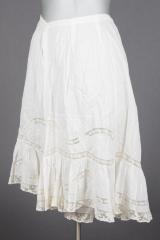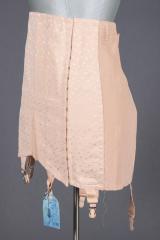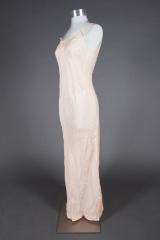Comments and Tags
Be the first to comment on this item!
Clothing and Accessories
Women's Clothing
Undergarments
Voigt Family Collection ➔ Girdle and Box
Identifier:
V1403.5a-bDescription:
This peach-colored Lotus girdle is made of floral-patterned rayon. It has elastic on the sides and at the top of the back. There are six loop and button clips that hang from the bottom of the girdle. This style of clip was ideal for thin stockings like the ones popular in the mid-1900s. Hook and eye closures can be seen on the front of the proper left side. This girdle has an interior label that reads "Lotus" and there is a stamp on one of the bones that verify it is a size 34. There is another label that reads "Manufactured Under Corset & Brasserie Code Authority". This girdle is accompanied by its box which verifies the size and model number.This Lotus girdle was worn by a member of the Voigt family of Grand Rapids, Michigan.
Date:
circa 1920 – 1950Materials:
Rayon, Elastic, CottonDimensions:
33.5" h 14.5" wCurrent Location Status:
In StorageCollection Tier:
Tier 2Source:
Gift of Kent County Council for Historic PreservationRelated Entities:
Lotus (creator) Voigt House (used by)Alternate names: Voigt Family
The Voigt family, whose home is now preserved by the Grand Rapids Public Museum, moved to the city in 1875 and resided at 133 Court Street (now Scribner Street). The Voigt family partnered with the Herpolsheimer family in the dry-good and carpet business and in a few years the partnership expanded to include two flour mills -- the Crescent and Star mills located on the Grand River. In 1902 the partnership came to a mutual end. The Herpolsheimer family retained the dry-good store and the Voigt family kept the two mills. By the turn of the century, Voigt flour under several brand names, and later Voigt Cereal, were known across Michigan and far east as New England. Due to bankruptcy and a strike, the flour milling business came to an abrupt end in 1955. In 1895, Carl G.A. Voigt hired local architect William G. Robinson to design a house on 115 College Avenue Southeast to serve as his retirement home. It was modeled after the chateaux at Chenoceaux, France. The home is a fine example of Victorian architecture and complemented the Victorian family that lived in it. It was lived in by just the Voigt family which was comprised of Carl Gustav Adolf Voigt, his wife Elizabeth Wurster Voigt and their children. They were the parents of nine children with six surviving until adulthood. The family lived in the home from 1895 to 1971. Kent County Council for Historic Preservation (donor)
The Kent County Council for Historic Preservation has several responsibilities that support the preservation and protection of our history. These include:
- Recommending designation of new historic districts
- Reviewing applications for proposed alterations within historic districts
- Enforcing the Historic Preservation Ordinance Chapter and cooperating with the state, federal and local governments in pursuance of its responsibilities
- Conducting meetings or hearings necessary to carry out these purposes
The Historic Preservation Commission consists of seven members who reside in Grand Rapids. Members are appointed by the City Commission for three-year terms (two consecutive terms are allowed). Members shall have a demonstrated interest in or knowledge of historic preservation. Two members shall be appointed from a list submitted by the Kent County Council for Historic Preservation and one member shall be an architect duly registered in the State of Michigan.
http://grcity.us/design-and-development-services/Planning-Department/Pages/Historic-Preservation-Commission.aspx


